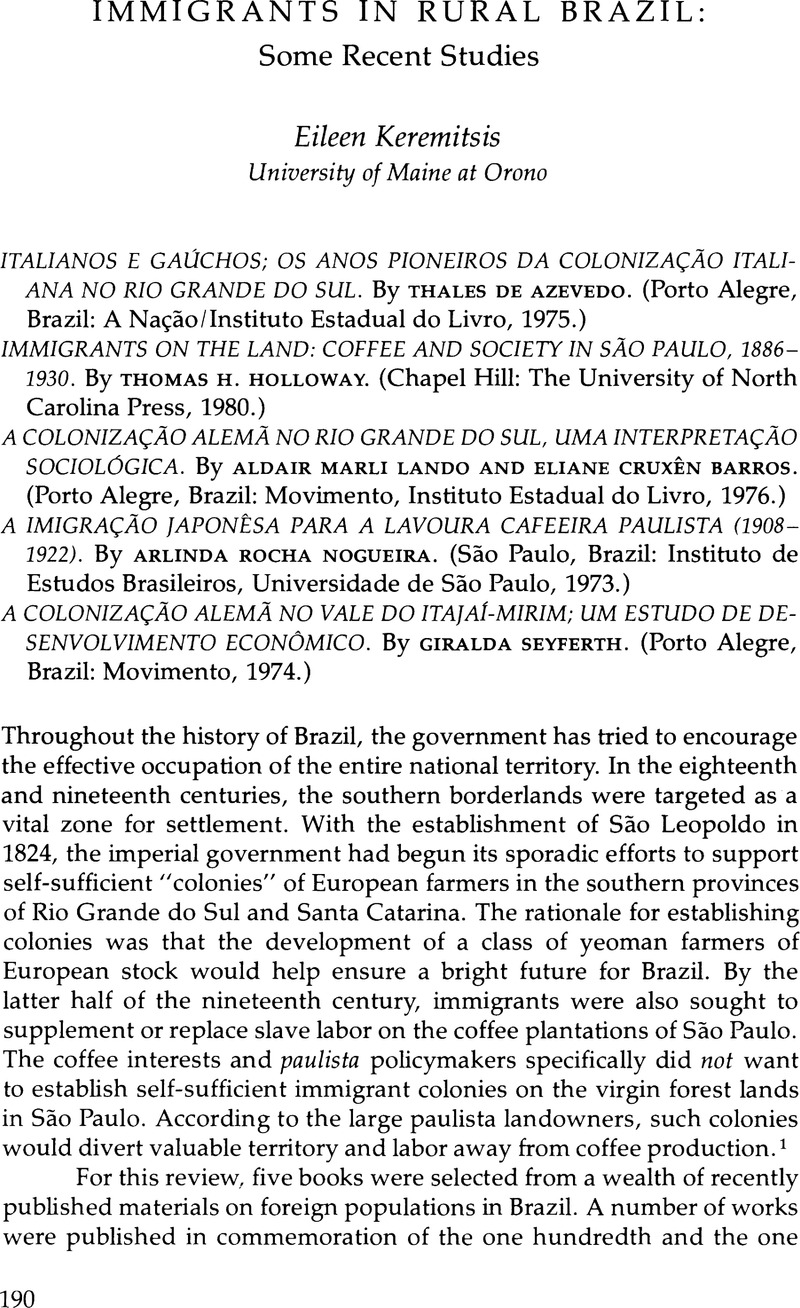Article contents
Immigrants in Rural Brazil: Some Recent Studies
Review products
Published online by Cambridge University Press: 24 October 2022
Abstract

- Type
- Review Essays
- Information
- Copyright
- Copyright © 1983 by the University of Texas Press
References
Notes
1. As the wage-labor system developed in São Paulo after abolition, most immigrant workers there were known as colonos although their role differed from that of the colonists in the South. Perhaps the distinction between the terms immigrant and colonist had been lost because so many earlier immigrants had, in fact, been colonists. For a discussion of colonos in São Paulo, see Warren Dean, Rio Claro: A Brazilian Plantation System, 1820-1920 (Stanford, California: Stanford University Press, 1976) 168-69; and Holloway, Immigrants, pp. 70-74.
2. A good overview of the role of immigration in Brazilian history is given in chapter 5 of Thomas W. Merrick and Douglas H. Graham, Population and Economic Development in Brazil: 1800 to the Present (Baltimore: The Johns Hopkins University Press, 1979). Recently published primary sources include Thomas Davatz, Memórias de um Colono no Brasil (1850), translation, notes, and preface by Sergio Buarque de Holanda (São Paulo: Martins, 1972); Francisco Cupello, Memórias de um Imigrante (Rio de Janeiro: Casa Editôra Vecchi, 1973); and two volumes by Rovílio Costa, et al., Imigração Italiano no Rio Grande do Sul: Vida, Costumes e Tradições (Porto Alegre: Livraria Sulina, 1974) and Antropologia Visual da Imigração Italiana (Caxias do Sul: Universidade de Caxias and Escola Superior de Teologia São Lourenço de Brindes, 1976). The secondary works on immigration in Brazil are too numerous to list here.
3. Among the criteria that Willems considers are: the similarities of physical and cultural environments of both home and host countries, expectations of permanent relocation in the host country, the presence or absence of prejudices about the immigrants' culture and race, language, family structure, religion, economic activities, education, law, and politics. See Emilio Willems, Assimilação e Populações Marginais no Brasil: Estudo Sociológico dos Imigrantes Germânicos e Seus Descendentes, Brasiliana, Série 5a., v. 186 (São Paulo: Companhia Editôra Nacional, 1940).
4. On the “whitening” process, see Thomas E. Skidmore, Black into White: Race and Nationality in Brazilian Thought (New York: Oxford University Press, 1974).
5. See, for example, Aurélio Porto, O Trabalho Alemão no Rio Grande do Sul (Porto Alegre: Estabelecimento Gráfico Santa Terezinha, 1934), pp. 187-91.
6. For a dissenting opinion of the structure and function of towns in rural Brazil and Germany, see Willems, Assimilação, p. 80.
7. One example of the “new” social history applied to immigrant mobility in the United States is Thomas Kessner, The Golden Door: Italian and Jewish Immigrant Mobility in New York City, 1880-1915 (New York: Oxford University Press, 1977).
8. See Frederick Jackson Turner, The Frontier in American History (New York: H. Holt and Company, 1947).
9. Dean, Rio Claro, p. 190.
10. Other works on the Japanese in Brazil that have appeared in Western languages include José Thiago Cintra, La migración japonesa en Brasil (México: El Colegio de México, Centro de Estudios Orientales, 1971); Burajiru Nikkeijin Jittai Chosa Iinkai, The Japanese Immigrant in Brazil (Tokyo: The University of Tokyo Press, n.d.); Hiroshi Saito, “The Integration and Participation of the Japanese and Their Descendants in Brazilian Society,” International Migration 14,3 (1976):183-99.
11. For examples of such comparative studies, see: Herbert S. Klein, “The Integration of Italian Immigrants into Argentina and the United States: A Comparative Analysis,” paper presented at the conference “Imprenditori e Lavoratori Italiani nel proceso d'industrializzazione dell'America Latina” in Torino, Italy, September-October 1980; and Chiari Vangelista, “Immigrazione, struttura produttiva e mercato del lavoro in Argentina e in Brasile: 1876-1914,” Annali della Fondazione Luigi Eiunaudi 9 (1975): 197-216.
- 1
- Cited by




